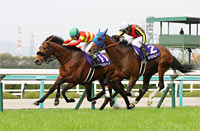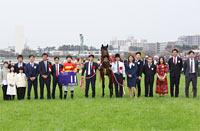2020 News
Matured Lucky Lilac Finishes Strongly to Win Osaka HaiSecond favorite Lucky Lilac improved on her runner-up effort in the Nakayama Kinen (G2, 1,800m) last month to captured her third G1 title in this year’s Osaka Hai which was held without the usual cheering crowd due to precautionary measures against COVID-19 taken by the JRA. The Hanshin Juvenile Fillies (G1, 1,600m) victor and 2017 Best Two-Year-Old Filly landed her second G1 victory last November in the Queen Elizabeth II Cup (2,200m) and concluded her four-year-old campaign with a runner-up effort in the Hong Kong Vase (G1, 2,400m). Trainer Mikio Matsunaga claimed his fifth career G1 title (steeplechases included)—the last being the Queen Elizabeth II Cup with the same horse. Jockey Mirco Demuro landed his 31st JRA-G1 title, the first since the 2019 Yushun Himba (Japanese Oaks) with Loves Only You. He also won the 2018 edition of the Osaka Hai with Suave Richard, a year after the race was upgraded to G1 status. Lucky Lilac broke sharply from a good draw but allowed race favorite Danon Kingly to pass and dictate a moderated pace and eased to third along the rails, a few lengths behind the pace setter and Jinambo who stalked the leader in second. While keeping an eye on Chrono Genesis who made her move towards the outside route turning for home, Mirco Demuro kept the Orfevre mare to the inside, and did not miss the chance as Jinambo began to tire with 200 meters to go and slipped through to the outside of Danon Kingly, increasing her strides impressively to out-win both Chrono Genesis and Danon Kingly for a neck victory. “I really miss the fans that were unable to come and watch the race, but it’s always a great feeling to be able to win a G1 race. Lucky Lilac was well prepared for coming into this race after a prep at Nakayama where she found the uphill still a little tough at the finish—she was definitely very strong and fit this time. She was really sharp coming out of the gate and we were a little forwardly positioned than expected but the race went perfectly for us and she was really concentrating and taking the bit after the third corner—we were lucky to find a nice opening at the stretch. She’s a mare but a not timid and has the strength to face the top males in the future,” commented Mirco Demuro. Chrono Genesis broke smoothly from an outside draw and gradually moved up to settle in fourth position, outside and half a length behind the eventual winner. The Bago filly made her move approaching the fourth corner, overtaking Lucky Lilac and shifting to the outside for the stretch run, and while she was able to pin down Danon Kingly who gave a good fight to maintain his lead, she was a neck short in second at the wire after having to cover more ground than the winner who came from the inside. Race favorite Danon Kingly was looking to capture his first G1 title in this race and turned in a strong performance in defeat. Breaking sharply and allowed to dictate a moderate pace with Jinambo close in second on his outside, the Deep Impact colt held on gamely while threatened by the first two finishers in the last furlong and crossed the wire a neck-neck third.Other Horses: THE 64TH OSAKA HAI (G1)
FP: Final Position / BK: Bracket Number / PP: Post Position / S&A: Sex & Age / Wgt: Weight (kg) / DH: Dead Heat / L3F: Time of Last 3 Furlongs (600m)
Color: b.=bay / bl.=black / br.=brown / ch.=chestnut / d.b.=dark bay / d.ch.=dark chestnut / g.=gray / w.=white
Turnover for the Race alone: ¥ 12,012,697,800 Turnover for the Day: ¥ 20,783,501,200 PAY-OFF (for ¥100)
Winner= 15 starts, 6 wins, 4 seconds, 2 thirds / Added money: ¥ 137,604,000 / Career earnings: ¥ 627,264,700
* Osaka Hai (G1) The Osaka Hai, renewing its name in 2017 from the familiarly known Sankei Osaka Hai, was established in 1957 as a handicap race open to runners of four years of age and upwards run over 1,800m at Hanshin Racecourse in March. After the distance was extended to 2,000m in 1972, the date was moved to one week earlier to the Oka Sho (Japanese 1000 Guineas) in 1981. The race was given G2 status in conjunction with the new grading system in 1984, opened its doors to foreign competitors in 2003 and was upgraded to G1 in 2017. The winner of the race will automatically earn a starting position in the Irish Champion Stakes (G1, 2,000m) held in September. Attracting strong contenders by serving as a prep race for G1 spring races for older horses such as the Tenno Sho (Spring) (G1, 3,200m) and the Takarazuka Kinen (G1, 2,200m), many Osaka Hai champions have gone on to achieve G1 successes; Meisho Samson (JPN, by Opera House) in 2007, Hiruno d’Amour (JPN, by Manhattan Cafe) in 2011, two-time Horse of the Year Kitasan Black (JPN, by Black Tide) in 2017, all went on to capture the Tenno Sho (Spring) that followed; and Dream Journey (JPN, by Stay Gold) in 2009 landed his Takarazuka Kinen victory two starts later. 2018 victor Suave Richard (JPN, by Heart’s Cry) captured his second G1 title in the Japan Cup (G1, 2,400m) last year. Winners who also showed extraordinary accomplishments include 2008 champion Daiwa Scarlet (JPN, by Agnes Tachyon), legendary 2013 winner Orfevre (JPN, by Stay Gold) and 2014 victor Kizuna (JPN, by Deep Impact). 2018 Arima Kinen (G1, 2,500m) winner Blast Onepiece registered his fifth graded title in the American Jockey Club Cup (G2, 2,200m; Jan.26), while last year’s Shuka Sho (G1, 2,000m) winner Chrono Genesis claimed her third grade-race victory in the Kyoto Kinen (G2, 2,200m; Feb.16) against male opponents. Last year’s Tokyo Yushun (Japanese Derby, G1, 2,400m) runner-up Danon Kingly claimed his third graded title in the Nakayama Kinen (G2, 1,800m; Mar.1), the same race in which 2019 Queen Elizabeth II Cup (G1, 2,200m) winner Lucky Lilac came in second. Those who came off the Kinko Sho (G2, 2,000m; Mar.15) were Satono Saltus (2nd) and Lord My Way (10th). The field also included two Derby winners, Wagnerian and Makahiki who finished third and fourth in the Japan Cup last year, respectively. |
|




















